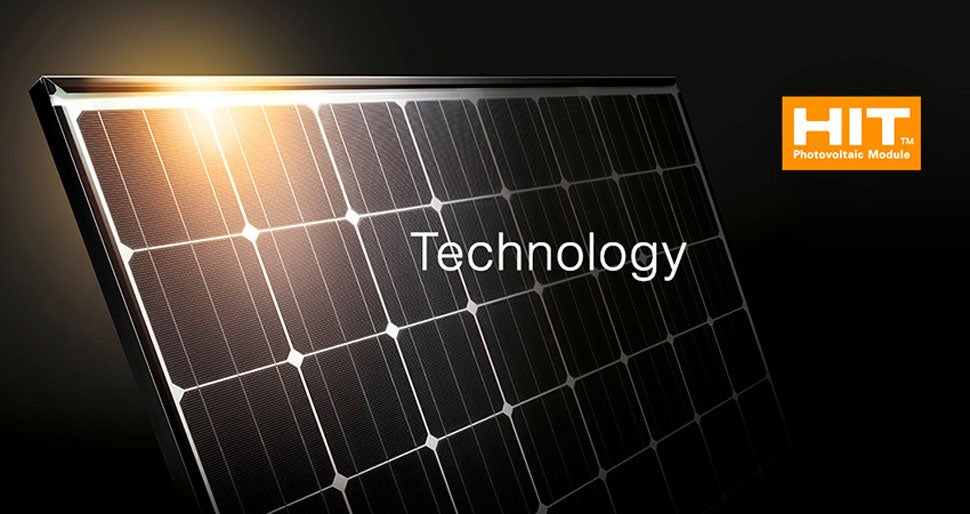
Panasonic has been a staple of the solar panel industry since 1975. Initially, the Japan-based company focused on manufacturing amorphous solar modules, which are also called "thin film solar panels". In 1997, Panasonic shifted its focus to a new type of solar panel that they have since become known for: HIT modules.
Despite being a popular solar panel brand, Panasonic announced that they would no longer manufacture their own solar panels and pulled out of their manufacturing deal with Tesla. Instead, any Panasonic-branded panels after 2022 would be manufactured by a third-party company. However, their energy storage products and inverters will still be manufactured in their Japanese factory.
Let’s take a look at the products Panasonic currently offers, and what the future holds for them.
Key takeaways
- Panasonic panels typically cost about $3.10 per watt to install.
- Panasonic uses HIT and half-cut solar cell technology so their panels can operate better under real-world conditions, and can convert more sunlight into electricity.
- Panasonic’s solar warranty is better than most warranties on the market, guaranteeing that its panels will operate between 90% and 92% of their initial power rating after 25 years.
- Panasonic announced they will no longer manufacture their own solar panels after March 2022. While this could lead to lower quality panels, it’s not guaranteed that the quality will change.
What solar cell technology do Panasonic solar panels use?
The unique heterojunction (HIT) solar cells used by Panasonic in their solar modules incorporates both crystalline and amorphous solar technology to retain more power that is typically lost through conventional crystalline cells.
HIT, or heterojunction, solar cells are manufactured like a sandwich - a thin, monocrystalline silicon layer is layered between two thin amorphous silicon layers. The result is a high-efficiency, high-performing solar cell.
Panasonic’s newest line of solar panels, the EverVolt series, don’t just use HIT solar cells, they use half-cut HIT solar cells. Half-cut cells are exactly what they sound like - photovoltaic solar cells that have been cut in half. By making the cells smaller, there are lower heat losses, which increases their efficiency.
Below, SolarReviews founder and President Andy Sendy provides his insight about Panasonic solar panels.
How much do Panasonic solar panels cost?
Panasonic solar panels cost around $3.10 per watt to install. This is slightly more expensive than the average cost of solar in the U.S., which is about $3.00 per watt.
Considering Panasonic’s solid performance metrics and great warranty, this is a pretty good price, but you can still probably find comparable panels for cheaper. Plus, Panasonic solar power systems qualify for solar incentives and rebates that will lower overall installation costs, like the 30% federal solar tax credit.
How do Panasonic solar panels rank in terms of efficiency?
Solar panel efficiency is a measure of how much of the sunlight that hits a solar panel is actually converted into electricity. Most solar panels on the market today have a module efficiency rating between 15% and 20%. Anything above 20% is considered a premium-efficiency panel.
All of Panasonic’s solar panels are considered high-efficiency panels. Their HIT solar panels have conversion efficiencies ranging from 19.1% to 20.3%.
The Panasonic EverVolt panels have even higher efficiency ratings - falling between 20% and 22.2%. The EverVolt series’ higher efficiency rating comes from that half-cut solar cell technology we brought up earlier. It gives them a slight edge over Panasonic’s regular HIT panels.
However, compared to other solar panel performance metrics, solar panel efficiency doesn’t matter all that much. Instead, you should really look at the power output of the panel, which tells you how much electricity that panel can actually produce. Panasonic panels range from 350 watts to 410 watts in size, which is pretty standard for solar panels on the market today.
How do Panasonic solar panels perform in the real world?
HIT technology allows Panasonic solar cells to have the lowest temperature coefficient in the home solar industry.
Interestingly, solar panels actually don’t perform as well in high temperatures, and the temperature coefficient gives you insight into how much solar production will drop for each degree the surface temperature a solar panel gets above 77F (or 25?). The lower the temperature coefficient of a solar panel, the better.
Most solar panels on the market today have a temperature coefficient between -0.3% to 0.5%. Panasonic’s HIT panels have a temperature coefficient of just -0.285% / ?, meaning as it gets hotter, Panasonic’s panels will be able to produce more electricity than their competitors.
What is Panasonic’s solar panel warranty?
Panasonic panels come with two warranties: a product warranty and a performance warranty.
The Product Workmanship warranty guarantees the panels will be free from defects so long as they are used as intended and installed properly for 15 years. If you register the panels with Panasonic, the warranty will be extended to 25 years.
As solar panels age, they aren’t able to produce as much electricity. A solar panel’s performance warranty will give you an idea of how panels will produce power over time - you want the degradation rate to be as low as possible.
Panasonic HIT panel warranty
For the HIT series, Panasonic guarantees the panels will operate at 97% of their initial capacity after Year 1, and will not degrade more than 0.26% annually for the remaining 24 years of the warranty period. After 25 years, the panels should operate at 90.76% of their original wattage.
That Year 1 degradation is a little higher than we’d like to see; most panels have a Year 1 degradation rate of about 2%. However, the annual degradation rate of 0.26% is much lower than what we see for most solar panels on the market today, which is around 0.5%.
So, despite having a higher Year 1 degradation rate, Panasonic’s low annual degradation rate means that the HIT solar panels will be able to produce more electricity than their competitors as they age.
Panasonic EverVolt panel warranty
The 25-year warranty for the EverVolt panels is even better than the HIT series warranty.
Panasonic guarantees their EverVolt panels will operate at 98% of their initial power rating after Year 1, and will not degrade more than 0.25% annually for the remaining 24 years of the warranty period. After 25 years, the panels should operate at 92% of their initial power rating.
The Evervolts’ Year 1 degradation rate falls in line with industry standards, and the annual rate of 0.25% is still substantially lower than the 0.5% rate that most panels come with. In fact, this is one of the best solar panel performance warranties available.
Pros and cons of Panasonic solar panels
Advantages
- Impressive specs
- Excellent warranty
- Lower price than premium panels
- Reputable company
Panasonic panels, specifically their EverVolt modules, come with great performance specs and a fantastic warranty. While their products’ performance falls just shy of premium brands like SunPower, the panels also come at a little bit of a lower price.
Plus, being that Panasonic is a large, reputable company, you can trust that they will be honoring their warranty should you need to file a claim.
Disadvantages
- You can buy comparable panels at a lower cost
- The panels will be manufactured by a third party
The biggest disadvantage to Panasonic solar panels is, while they’re cheaper than SunPower, you can still find other solar panels that will meet your needs at a cheaper price point.
Another big thing to keep in mind is that Panasonic recently announced it will no longer manufacture its own solar panels. Instead, another company will take over manufacturing, but the panels will still have Panasonic’s name.
There’s no guarantee that these panels will be of the same quality as the panels Panasonic manufactured in-house, or that they’ll even offer these same module product lines. Only time will tell what the future holds for the quality of Panasonic’s solar energy branch.
You can check out our top 10 list of solar panel manufacturers to see what other panels you should keep your eyes out for when going solar.
Would our SolarReviews experts choose Panasonic panels for their roofs?
Yes, Panasonic panels are an excellent choice for customers looking to install a high-quality, reliable solar system without giving up your life's savings. We recommend going with Panasonic’s EverVolt panels as opposed to their HIT panels, as the EverVolt panels perform better and come with a better warranty.
The EverVolt series is also a better choice for homeowners who might want to install battery storage, as they are designed to pair with Panasonic’s EverVolt solar battery.
Just keep in mind that Panasonic panels sold after March 2022 will not be manufactured by Panasonic themselves. This doesn’t mean the quality of the panels will definitely decrease - there are a ton of companies across all industries that outsource their manufacturing - but we can’t know for sure if the manufacturing will be up to our standards.
So, if you’re dead-set on getting the Panasonic brand and you want to ensure the best quality possible, you should consider going solar sooner rather than later.
